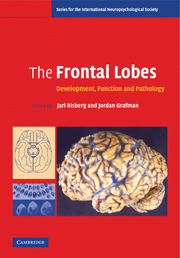Book contents
- Frontmatter
- Contents
- Contributors
- From the series editor
- Introduction
- 1 Evolutionary aspects on the frontal lobes
- 2 Organization of the principal pathways of prefrontal lateral, medial, and orbitofrontal cortices in primates and implications for their collaborative interaction in executive functions
- 3 Human prefrontal cortex: processes and representations
- 4 A microcircuit model of prefrontal functions: ying and yang of reverberatory neurodynamics in cognition
- 5 Prefrontal cortex: typical and atypical development
- 6 Case studies of focal prefrontal lesions in man
- 7 Left prefrontal function and semantic organization during encoding and retrieval in healthy and psychiatric populations
- 8 Clinical symptoms and neuropathology in organic dementing disorders affecting the frontal lobes
- Index
- Plate section
- References
4 - A microcircuit model of prefrontal functions: ying and yang of reverberatory neurodynamics in cognition
Published online by Cambridge University Press: 11 September 2009
- Frontmatter
- Contents
- Contributors
- From the series editor
- Introduction
- 1 Evolutionary aspects on the frontal lobes
- 2 Organization of the principal pathways of prefrontal lateral, medial, and orbitofrontal cortices in primates and implications for their collaborative interaction in executive functions
- 3 Human prefrontal cortex: processes and representations
- 4 A microcircuit model of prefrontal functions: ying and yang of reverberatory neurodynamics in cognition
- 5 Prefrontal cortex: typical and atypical development
- 6 Case studies of focal prefrontal lesions in man
- 7 Left prefrontal function and semantic organization during encoding and retrieval in healthy and psychiatric populations
- 8 Clinical symptoms and neuropathology in organic dementing disorders affecting the frontal lobes
- Index
- Plate section
- References
Summary
Introduction
In contrast to neural systems responsible for sensory processing or motor behavior, the prefrontal cortex is a quintessentially “cognitive” structure. A bewildering gamut of complex higher brain processes depend on prefrontal cortex. It is thus a particularly challenging quest to elucidate the neurobiology of prefrontal functions at the mechanistic level. Patricia S. Goldman-Rakic voiced this difficulty in 1987:
Unlike largely sensory and motor skills, the mnemonic, associative, and command functions of the mammalian brain have eluded precise neurological explanation. The proposition that cognitive function(s) can be localized to specialized neuronal circuits is not easy to defend because the neural interactions that underlie even the most simple concept or solution of an abstract problem have not been convincingly demonstrated. Also it does not seem possible to conceptualize in neural terms what it means to generate an idea, to grasp the essentials of a situation, to be oriented in space and time, or to plan for long-range goals. Furthermore we are still learning how to formulate the structure-function problem in a way that can lead to fruitful experimentation, theory building, or modeling in terms of neural systems or synaptic mechanisms.
Since these words were written, some of the impediments have begun to yield ground, partly thanks to the development of novel techniques linking cognitive functions with underlying neural processes. The advent of functional magnetic resonance imagining (fMRI) has opened up a window with which brain activity can be probed and dissected during behavior.
- Type
- Chapter
- Information
- The Frontal LobesDevelopment, Function and Pathology, pp. 92 - 127Publisher: Cambridge University PressPrint publication year: 2006
References
- 9
- Cited by



